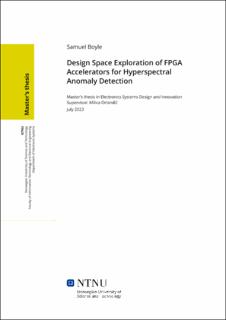| dc.contributor.advisor | Milica Orlandić | |
| dc.contributor.author | Boyle, Samuel | |
| dc.date.accessioned | 2023-09-29T17:21:13Z | |
| dc.date.available | 2023-09-29T17:21:13Z | |
| dc.date.issued | 2023 | |
| dc.identifier | no.ntnu:inspera:143674355:134139556 | |
| dc.identifier.uri | https://hdl.handle.net/11250/3093196 | |
| dc.description.abstract | Små satellitter, slik som de i HYPerspectral small Satellite for ocean Observation (HYPSO)-oppdraget, representerer en form for innebygd system preget av sterkt begrensede kommunikasjonsevner. For å overvinne disse begrensningene, fokuserer denne oppgaven på å utnytte rekonfigurerbare maskinvareakseleratorer for å muliggjøre effektiv og laveffektsbehandling av HyperSpectral Images (HSI-er) ombord på disse satellittene. Det spesifikke målet med denne oppgaven er å ta for seg og utforske maskinvareakseleratorer for avansert oppdagelse av anomalier. Algoritmen for avviksdeteksjon foredles til lavere abstraksjonsnivåer, noe som til slutt resulterer i en målimplementering egnet for Field Programmable Gate Array (FPGA) akselerasjon ved bruk av High Level Synthesis (HLS). Denne foredlingsprosessen sikrer sammenheng med eksisterende litteratur, bygger på implementeringen på høyt nivå og gir en analyse som identifiserer muligheter for ytterligere forbedringer. Deretter går oppgaven inn i designrommet til akseleratorarkitekturer, med et spesifikt fokus på AutoEncoder (AE)-komponenten. Gjennom en omfattende utforskning av designrommet foreslås arkitekturer som ligger på Pareto-grensen. Disse foreslåtte arkitekturene gir dominerende ytelse i estimater for ressursutnyttelse under syntese. Et undersett av arkitekturene er implementert og fysisk testet på FPGA. Resultatene viser betydelig hastighetsøkning, fra 85\% til 94\%, sammenlignet med ikke-akselererte implementeringer. Videre avslører de testede arkitekturene potensialet for enda raskere design, og understreker behovet for ytterligere finjustering og utforskning. Avslutningsvis, ved å oppnå betydelig hastighet og gi mange potensielle akseleratorer for forskjellige gjennomstrømninger, muliggjør dette arbeidet effektiv behandling av HSI-er ombord, og bidrar effektivt til målene for HYPSO-programmet. Disse funnene etablerer et solid grunnlag for utvikling av potensielle design for å akselerere slutningen av anomalideteksjonsalgoritmer på spesifikke plattformer, for eksempel ZCU-104 MultiProcessor System on Chip (MPSoC) og HYPSO-1 Zynq-7030 System on Chip (SoC) . Disse foreslåtte designene har potensialet til å oppnå en gjennomstrømning på minst 140 MB/s, med ressursutnyttelse fra 70\% til 90\% på Zynq-7030 FPGA. Gir i tillegg en rekke høyere gjennomstrømningspotensial for MPSoC, samtidig som det fremhever muligheter for ytterligere foredling og optimalisering. | |
| dc.description.abstract | Small satellites, such as those in the HYPerspectral small Satellite for ocean Observation (HYPSO) mission, represent a form of embedded system characterised by heavily constrained communication capabilities. To overcome these constraints, this thesis focuses on leveraging reconfigurable hardware accelerators to enable efficient and low-power processing of HyperSpectral Images (HSIs) onboard these satellites. The specific objective of this thesis is to address and explore hardware accelerators for state-of-the-art anomaly detection. The anomaly detection algorithm is refined into lower levels of abstraction, eventually resulting in a target implementation suitable for Field Programmable Gate Array (FPGA) acceleration using High Level Synthesis (HLS). This refinement process ensures coherency with existing literature, builds upon the high-level implementation, and provides an analysis that identifies opportunities for further improvements. Subsequently, the thesis delves into the design space of accelerator architectures, with a specific focus on the AutoEncoder (AE) component. Through a comprehensive exploration of the design space, architectures that lie on the Pareto frontier are proposed. These proposed architectures provide dominant performance in resource utilisation estimates during synthesis. A subset of the architectures are implemented and physically tested on the FPGA. The results demonstrate significant speedup, ranging from 85\% to 94\%, compared to non-accelerated implementations. Furthermore, the tested architectures reveal the potential for even faster designs, emphasising the need for further fine-tuning and exploration. In conclusion, by achieving substantial speedup and providing numerous potential accelerators for different throughputs this work enables efficient onboard processing of HSIs, effectively contributing to the mission objectives of the HYPSO program. These findings establish a solid foundation for the development of potential designs to accelerate the inference of anomaly detection algorithms on specific platforms, such as the ZCU-104 MultiProcessor System on Chip (MPSoC) and HYPSO-1 Zynq-7030 System on Chip (SoC). These proposed designs hold the potential to achieve a throughput of at least 140 MB/s, with resource utilisation ranging from 70\% to 90\% on the Zynq-7030 FPGA. Additionally providing a range of higher throughput potential for the MPSoC while simultaneously highlighting opportunities for further refinement and optimisation. | |
| dc.language | eng | |
| dc.publisher | NTNU | |
| dc.title | Design Space Exploration of FPGA Accelerators for Hyperspectral Anomaly Detection | |
| dc.type | Master thesis | |
